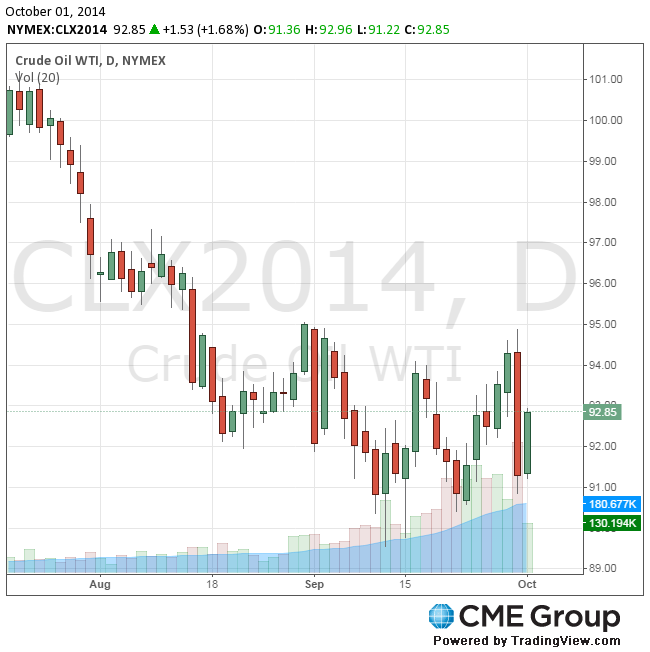Notícias do Mercado
-
23:33
Commodities. Daily history for Oct 1'2014:
(raw materials / closing price /% change)
Light Crude 90.70 -0.03%
Gold1,213.50 -0.16%
-
16:40
Оil rose
West Texas Intermediate oil rose from a 17-month low after U.S. crude supplies dropped to the least since January. Brent rebounded from the lowest level in more than two years in London.
Crude stockpiles slipped 1.36 million barrels to 356.6 million, according to an Energy Information Administration report today. Inventories were forecast to rise by 1.5 million barrels, according to a Bloomberg survey of analysts. Prices will probably rebound this quarter as Saudi Arabia cuts output and global demand increases, according to UBS AG and Barclays Plc.
"Prices are up because of these inventory numbers," Bob Yawger, director of the futures division at Mizuho Securities USA Inc. in New York, said by phone. "We're going to probably see futures move to the $93-$94 area. The slide has been stopped for the time being."
WTI for November delivery advanced $1.24, or 1.4 percent, to $92.40 a barrel at 10:58 a.m. on the New York Mercantile Exchange. Futures traded at $91.94 before the release of the EIA data at 10:30 a.m. in Washington. Futures slid $3.41 to $91.16 yesterday, the biggest one-day decline since November 2012.
Brent for November settlement gained $1.02, or 1.1 percent, to $95.69 a barrel on the London-based ICE Futures Europe exchange. Yesterday's close of $94.67 was the lowest since June 28, 2012. The European benchmark crude traded at a $3.29 premium to WTI.

-
16:20
Gold rose
Gold prices rose to a minimum of nine months, in spite of the strong dollar and weak demand in China, the largest consumer.
In September, the precious metal fell by 6 per cent, which was the highest decline since June 2013, and the first time this year, finished the quarter in the red.
Dollar exchange rate on Wednesday rose to a six-year high against the yen and is close to a two-year peak against the euro.
"As long as the dollar continues to rise, the price of gold will fall. They are kept up to $ 1,200, but can fall below this mark, if the dollar continues to rally," - wrote in the report, analysts HSBC.
Some pressure on the dollar have data on manufacturing activity in the United States. Final data, published by the Institute for Supply Management (ISM), showed that in September manufacturing activity in the United States deteriorated, thus surpassing the average forecast of economists.
PMI index for the industrial sphere of the United States fell in September to 57.5 points versus 59.0 points in August, and preliminary values at the level of 57.9 points. A reading above 50 indicates expansion of industrial activity. Note that the last reading was below the estimates of experts - is expected to decrease to 58.6. Meanwhile. became known, the sub-index of production fell to 59.6 in September from 60.7 in August, while the employment component rose to 56.4 from 54.6.
The world's largest reserves of the gold-exchange-traded fund SPDR Gold Trust Tuesday fell by 2.39 tonnes to 769.86 tonnes - the lowest level since December 2008.
Chinese markets are closed next week for the National Day. Meanwhile in Hong Kong continues thousands of performances fighters for democracy, which is opposed to the police.
The cost of the October gold futures on the COMEX today rose to 1218.60 dollars per ounce.

-